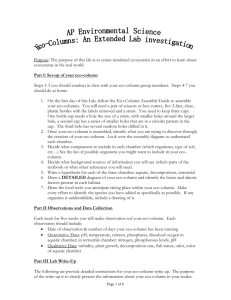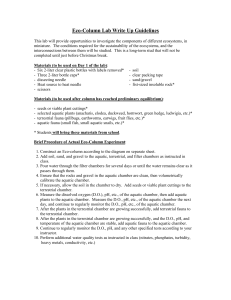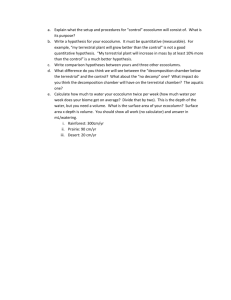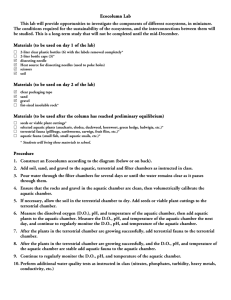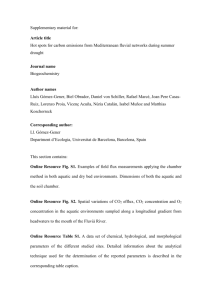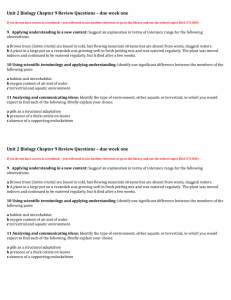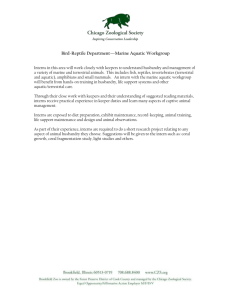Ecocolumn Lab Write Up Guidelines
advertisement
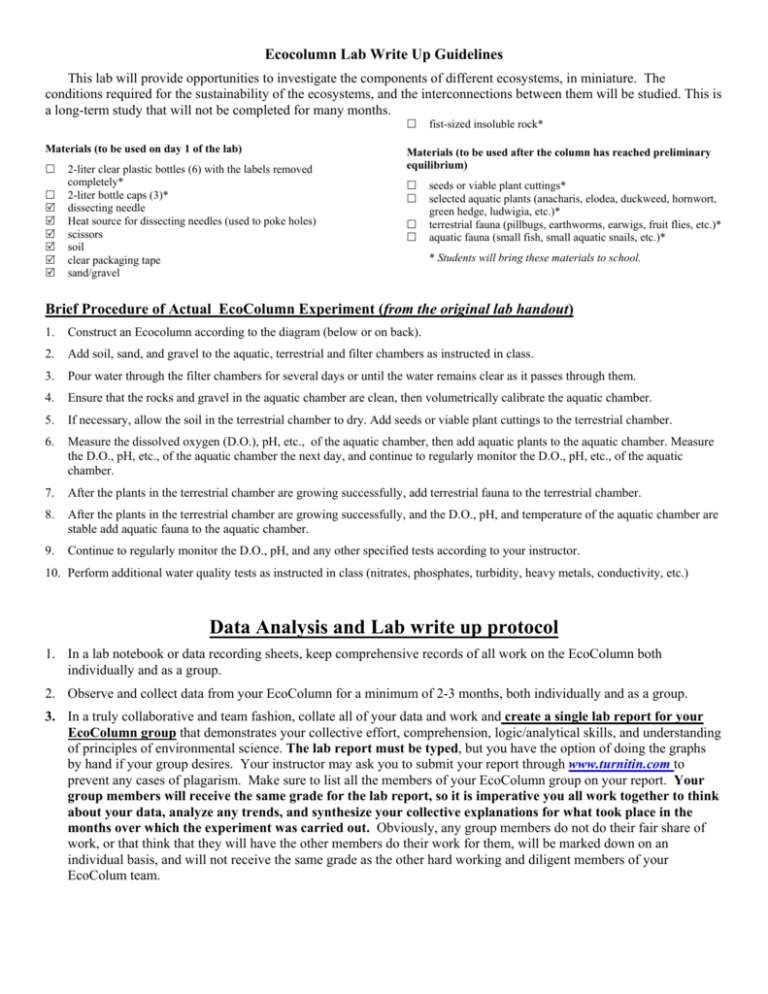
Ecocolumn Lab Write Up Guidelines This lab will provide opportunities to investigate the components of different ecosystems, in miniature. The conditions required for the sustainability of the ecosystems, and the interconnections between them will be studied. This is a long-term study that will not be completed for many months. Materials (to be used on day 1 of the lab) 5 5 5 5 5 5 2-liter clear plastic bottles (6) with the labels removed completely* 2-liter bottle caps (3)* dissecting needle Heat source for dissecting needles (used to poke holes) scissors soil clear packaging tape sand/gravel fist-sized insoluble rock* Materials (to be used after the column has reached preliminary equilibrium) seeds or viable plant cuttings* selected aquatic plants (anacharis, elodea, duckweed, hornwort, green hedge, ludwigia, etc.)* terrestrial fauna (pillbugs, earthworms, earwigs, fruit flies, etc.)* aquatic fauna (small fish, small aquatic snails, etc.)* * Students will bring these materials to school. Brief Procedure of Actual EcoColumn Experiment (from the original lab handout) 1. Construct an Ecocolumn according to the diagram (below or on back). 2. Add soil, sand, and gravel to the aquatic, terrestrial and filter chambers as instructed in class. 3. Pour water through the filter chambers for several days or until the water remains clear as it passes through them. 4. Ensure that the rocks and gravel in the aquatic chamber are clean, then volumetrically calibrate the aquatic chamber. 5. If necessary, allow the soil in the terrestrial chamber to dry. Add seeds or viable plant cuttings to the terrestrial chamber. 6. Measure the dissolved oxygen (D.O.), pH, etc., of the aquatic chamber, then add aquatic plants to the aquatic chamber. Measure the D.O., pH, etc., of the aquatic chamber the next day, and continue to regularly monitor the D.O., pH, etc., of the aquatic chamber. 7. After the plants in the terrestrial chamber are growing successfully, add terrestrial fauna to the terrestrial chamber. 8. After the plants in the terrestrial chamber are growing successfully, and the D.O., pH, and temperature of the aquatic chamber are stable add aquatic fauna to the aquatic chamber. 9. Continue to regularly monitor the D.O., pH, and any other specified tests according to your instructor. 10. Perform additional water quality tests as instructed in class (nitrates, phosphates, turbidity, heavy metals, conductivity, etc.) Data Analysis and Lab write up protocol 1. In a lab notebook or data recording sheets, keep comprehensive records of all work on the EcoColumn both individually and as a group. 2. Observe and collect data from your EcoColumn for a minimum of 2-3 months, both individually and as a group. 3. In a truly collaborative and team fashion, collate all of your data and work and create a single lab report for your EcoColumn group that demonstrates your collective effort, comprehension, logic/analytical skills, and understanding of principles of environmental science. The lab report must be typed, but you have the option of doing the graphs by hand if your group desires. Your instructor may ask you to submit your report through www.turnitin.com to prevent any cases of plagarism. Make sure to list all the members of your EcoColumn group on your report. Your group members will receive the same grade for the lab report, so it is imperative you all work together to think about your data, analyze any trends, and synthesize your collective explanations for what took place in the months over which the experiment was carried out. Obviously, any group members do not do their fair share of work, or that think that they will have the other members do their work for them, will be marked down on an individual basis, and will not receive the same grade as the other hard working and diligent members of your EcoColum team. The group lab write up will include the following: • Do some background research on EcoColums, by finding three websites that have information related to an EcoColum like experiment. List the three website URL’s in a bibliography, and provide a brief summary of the information from each website and how it helped you to understand the EcoColumn dynamics. Areas you might want to think about include the photosynthetic productivity, ecologic interactions (producer-consumer, predator- prey, etc.), matter and nutrient cycling, reasons for long term stability of the Eco EcoColumn, or reasons for lack of stability in any of the EcoColumn chambers- aquatic, terrestrial, or filtration. • Some general working hypothesis related to the stability, or health, or resilience, or survivabilty of the EcoColumn, in relation to the variables that were manipulated over the course of the experiment, and whether your hypothesis was supported or not. • A basic Procedure & Materials section (Do not just copy the one from the lab handout! You can just list the basic materials utilized, but what is more important is the procedure portion of the write up, for what you did over the course of the lab). Someone should be able to read this part of your write up and have a good general idea of what you did over the whole experiment and what materials you utilized. Think of this section as more of an abstract or overview of the experiment, with a list of critical ingredients necessary for someone to recreate your lab. • A data section-->all observations (BOTH qualitative and quantitative) (i.e. I want all of your data in some organized manner) Your group data must be typed, and it must be organized in some logical fashion that is easy to read. The manner in which you organize your data is up to your group. • Graphs of 7 specific items measured over the course of the experiment (dissolved oxygen, pH, nitrate, nitrite, total hardness, total chlorine, and iron). You may share graphs for your group, and the rest of the lab report work can be divided amongst your group your group sees fit, but I require one cohesive report from per EcoColumn group. Computer generated or hand done graphs are equally as appropriate. 4. At the conclusion of the lab, a thoughtful, scientifically valid, and conclusion/discussion will be completed. Your conclusion is the portion where you try to explain what you think happened in the lab based upon the data you collected (qualitative and quantitative). Your conclusion should relate back your general working hypothesis for the lab. Most hypotheses will relate to the general health, resiliency, stability, and cyclic processes (i.e. nitrogen cycle, etc.) that are demonstrated by the EcoCoulmn. 5. Any error analysis or potential improvements to the lab. 6. Complete the extension questions below, where you group applies its collective intellect and knowledge of the EcoColumn to realistic and relevant applications in the real world. A. List at least three different ecological problems (regional, national, or global) that your research would be applicable to in terms of providing basic research or useful scientific information. For each ecological problem identified, thoroughly explain how your research and knowledge is applicable to the problems identified. B. List two potential business or industrial applications you can think of where your research from the EcoColum experiment could be applied. Again, your examples should be thoroughly explained and clearly identified. Your ideas can be something already in the market or industry, or you can use your collective powers of imagination to brainstorm novel or new applications for your knowledge. C. Describe a current, local (within say 50 miles of TPHS) environmental problem, where your EcoColumn research could be applied and explain how your information would be integrated in solving the problem. D. Explain how the duration (time) for the EcoColumn experiment was necessary to get any meaningful outcomes and data, and how this experiment compares to real systems in nature in regards to time. E. Think about some of the major themes and processes demonstrated by the EcoColumn experiment, and identify tow pertinent or applicable environmental laws/legislation that would be related to things you have learned about as a group over the experiment. F. Summarize your groups overall perception of the EcoColmn lab process, and what you enjoyed most and least about the process Diagram of the Ecocolumn Base of bottle w/very small holes to allow slow drainage Terrestrial Chamber Caps (enlarged view) w/small holes that allow water to pass through slowly Filter Chamber Aquatic Chamber Window-for removing water samples Permanent marks indicate volume every 100 milliliters beginning at 1 liter
